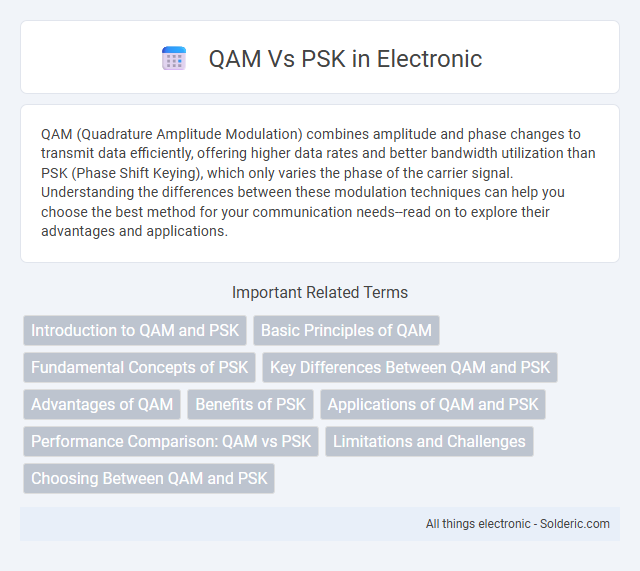QAM (Quadrature Amplitude Modulation) combines amplitude and phase changes to transmit data efficiently, offering higher data rates and better bandwidth utilization than PSK (Phase Shift Keying), which only varies the phase of the carrier signal. Understanding the differences between these modulation techniques can help you choose the best method for your communication needs--read on to explore their advantages and applications.
Comparison Table
| Feature | QAM (Quadrature Amplitude Modulation) | PSK (Phase Shift Keying) |
|---|---|---|
| Modulation Type | Amplitude and Phase modulation combined | Phase modulation only |
| Signal Constellation | 2D grid of amplitude and phase points | Points on a constant amplitude circle |
| Data Rate | Higher bit rates with more constellation points (e.g., 16-QAM, 64-QAM) | Lower bit rates per symbol compared to QAM (e.g., BPSK, QPSK) |
| Noise Sensitivity | More sensitive to amplitude noise and distortion | More robust against amplitude noise, sensitive to phase noise |
| Complexity | Higher receiver complexity due to amplitude and phase detection | Lower complexity receivers, simpler implementation |
| Common Applications | High-speed data transmission in cable modems, DSL, and Wi-Fi | Wireless communication (GSM, satellite), robust low-rate links |
| Power Efficiency | Less power efficient due to variable amplitude | More power efficient with constant amplitude signals |
Introduction to QAM and PSK
Quadrature Amplitude Modulation (QAM) combines both amplitude and phase variations to transmit data efficiently, making it ideal for high-capacity communication systems. Phase Shift Keying (PSK) relies solely on altering the phase of the carrier signal, offering robustness against amplitude noise and simpler implementation. Understanding these modulation techniques enables you to choose the best method for balancing data rate and signal integrity in your communication design.
Basic Principles of QAM
QAM (Quadrature Amplitude Modulation) combines both amplitude and phase variations to encode multiple bits per symbol, increasing data transmission efficiency compared to PSK (Phase Shift Keying), which relies solely on phase changes. Your communication system benefits from QAM's ability to transmit higher data rates within the same bandwidth by varying signal amplitude and phase simultaneously. This results in improved spectral efficiency and better utilization of channel capacity in digital communication systems.
Fundamental Concepts of PSK
Phase Shift Keying (PSK) modulates digital signals by altering the phase of a carrier wave, representing data through distinct phase angles. It efficiently transmits information by encoding bits into discrete phase shifts, such as in Binary PSK (BPSK) or Quadrature PSK (QPSK), enhancing spectral efficiency and robustness against noise. Your communication system benefits from PSK's simplicity and effectiveness in environments requiring reliable phase detection and error correction.
Key Differences Between QAM and PSK
QAM (Quadrature Amplitude Modulation) combines amplitude and phase variations to encode data, whereas PSK (Phase Shift Keying) relies solely on phase changes for signal modulation. QAM offers higher spectral efficiency by transmitting more bits per symbol, making it ideal for high-data-rate communication systems, while PSK provides better noise immunity and simpler implementation. Understanding these key differences helps you choose the optimal modulation technique for your specific communication requirements.
Advantages of QAM
QAM (Quadrature Amplitude Modulation) offers higher spectral efficiency compared to PSK (Phase Shift Keying) by encoding data in both amplitude and phase variations, allowing transmission of more bits per symbol. This modulation technique enhances data throughput in bandwidth-constrained communication systems, making it ideal for high-speed digital transmissions such as in cable modems and wireless broadband. Your network can benefit from QAM's improved signal robustness and capacity, especially in environments requiring efficient use of available spectrum.
Benefits of PSK
PSK (Phase Shift Keying) offers robust performance in noisy environments due to its constant amplitude, which reduces susceptibility to amplitude distortion and enables efficient power usage. Your communication system benefits from simpler receiver designs and improved spectral efficiency compared to other modulation schemes. PSK also supports reliable data transmission over long distances, making it ideal for wireless and satellite communications.
Applications of QAM and PSK
QAM (Quadrature Amplitude Modulation) is widely used in digital television broadcasting, cable modems, and high-speed wireless communication systems due to its ability to encode multiple bits per symbol, enhancing data throughput. PSK (Phase Shift Keying) is commonly employed in satellite communication, RFID systems, and Bluetooth technology where robust phase changes improve noise immunity and signal reliability. Both modulation schemes are integral to modern communication networks, with QAM favored for high-capacity channels and PSK for environments requiring robust signal integrity.
Performance Comparison: QAM vs PSK
QAM (Quadrature Amplitude Modulation) delivers higher spectral efficiency compared to PSK (Phase Shift Keying), enabling better data rates under identical bandwidth conditions. PSK offers superior resilience to phase noise and non-linear distortions, making it more reliable in noisy or fading channel environments. Your choice between QAM and PSK should consider the trade-off between data rate demands and the channel's noise characteristics for optimal performance.
Limitations and Challenges
QAM faces limitations in highly noisy environments where signal amplitude variations increase vulnerability to errors, while PSK performs better in such conditions but suffers from lower spectral efficiency compared to QAM. Both modulation schemes struggle with phase noise and nonlinearities in practical communication channels, affecting the accuracy and reliability of signal demodulation. Your system design must consider these challenges, including trade-offs between bandwidth efficiency and robustness to interference, to optimize performance in real-world applications.
Choosing Between QAM and PSK
Choosing between QAM and PSK depends on the trade-off between spectral efficiency and robustness to noise. QAM offers higher data rates by combining amplitude and phase modulation, making it ideal for bandwidth-limited systems, while PSK provides better performance in noisy environments due to its phase-only modulation. Your decision should consider the specific communication channel conditions and the required error tolerance to optimize system performance.
QAM vs PSK Infographic

 solderic.com
solderic.com